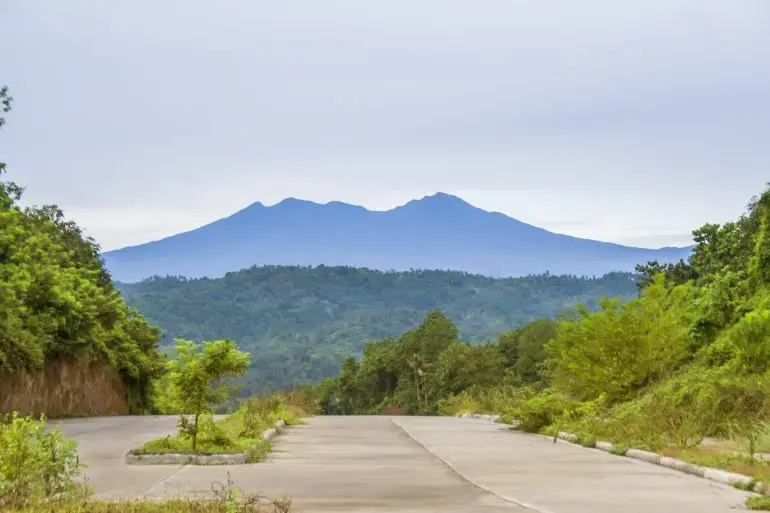Located in southeastern Asia near the equator, the Republic of the Philippines is an archipelago, or string, of between 7,100 and 7,640 islands in the Pacific Ocean. Remarkably, only about a third of the islands are inhabited and only two-fifths have names. Its three major island groups are, in order of size, Luzon, Mindanao, and Visayas. Together, Luzon and Mindanao make up two-thirds of its total land area.
Given its volcanic origin, the country’s terrain predominantly comprises mountains with narrow coastal lowlands. Mountain ranges span all three major island groups: Luzon houses the Sierra Madre, Caraballo Mountains, and Zambales Mountains. The Cordillera Central, a central chain in Luzon, has an average elevation of about 5,900 feet. On Mindanao, the Diwata Mountains along the eastern coast stand out, while in Visayas, the Central Panay Mountain Range is the most prominent.
With such a wealth of summits, the competition for the highest mountains in the Philippines is… well… high. So let’s get to it, starting with the biggest of the bunch.
Mount Apo

View of Mount Apo taken from Davao City, the largest mountain in The Philippines. (Credit: yullz via Getty Images)
With some fifty volcanoes throughout the country, several of the Philippines’ highest mountains have volcanic origins. This applies to the tallest one of all, Mount Apo. Also known as Apo Sandawa, this dormant stratovolcano is located at the meeting point of the regions of Davao and Soccsksargen on the island of Mindanao. There it rises to reveal three peaks, the southwestern of which is the tallest at an elevation of 9,692 feet above sea level, its summit crowned by a 656-foot crater lake. The southeastern side of the mountain also has several solfataras, which are sulphuric gas vents.
In addition to being among the tallest mountains in the Philippines, Apo’s impressive stature also earns it several other titles. For example, it’s the world’s 24th-highest island peak as well as the most-prominent mountain in the Philippines. What’s more, Mount Apo has enormous ecological and cultural significance. In terms of flora and fauna, there are some 270 bird species that call it home, almost half of them endemic. Among its resident avifauna is the iconic Philippine eagle, the largest in the world. It’s no wonder therefore to learn that it is protected within a Natural Park.
Mount Dulang-dulang

Mountains in Mindanao, Philippines (Credit: Jacob Maentz via Getty Images)
We remain on the island of Mindanao for the next entry, travelling around 80 miles northwest of Apo to Bukidnon province. There, the Kitanglad Mountain Range is the site of one of the last remaining rainforests in the country as well as some of the highest mountains in the Philippines. The tallest of these is Mount Dulang-dulang. Known simply as “D2” to mountaineers, it rises to 9,649 feet above sea level, making it the second highest peak in the country.
Flying lemurs, monkeys, bats, wild boars, squirrels, deer and shrews are just some of the wildlife that live within the biodiverse habitat of its forested slopes. These are protected by law as part of the Mount Kitanglad Range Protected Area.
Mount Pulag

Sunset over Mount Pulag, Philippines. (Credit: Dexter Baldon via Getty Images)
Not only is Mount Pulag third among the highest mountains in the Philippines, it’s also the country’s second-most prominent mountain and Luzon’s highest peak at 9,606 feet above sea level. Also known as Bundok Pulag, it’s a dormant volcano famed for the picturesque “sea of clouds” near its top.
Part of the Grand Cordillera Central, it’s located at the meeting point of the provinces of Benguet, Ifugao, and Nueva Vizcaya, its steep, rugged slopes lead up to a grassy, rolling summit. The mountain and surrounding area are teeming with biodiversity. From rare orchids to the endemic Luzon Pygmy Fruit Bat, and from Philippine Brown Deer to carnivorous pitcher plants, the variety and uniqueness of its flora and fauna are part of what led to its protection under the National Integrated Protected Areas Programme within Mount Pulag National Park.
Mount Tabayoc

Mountains in the Philippines (Credit: JAM STA ROSA via Getty Images)
Approximately six miles north of Mount Pulag is the second highest peak on the island of Luzon.
Mount Tabayoc has a total height of between 9,252 and 9,324 feet above sea level, making it one of the biggest mountains of the Philippines.
Mount Kalatungan

The rolling hills and mountainous landscape of The Philippines. (Credit: Nora Carol Photography via Getty Images)
Mount Kalatungan, also known as Catatungan, is a stratovolcano located in the Mindanao province of Bukidnon. Reaching 9,265 feet above sea level, it’s among the tallest mountains in the Philippines and lends its name to the Kalatungan Mountain Range.
Mayon Volcano

Mayon Volcano in the Philippines surrounded by rice fields (Credit: onfilm via Getty Images)
In southeastern Luzon, the Mayon Volcano is famed for the remarkable symmetry of its volcanic cone. Overlooking the city of Legaspi, it boasts a base 80 miles in circumference and rises to 8,077 feet above the Albay Gulf, making it one of the Philippines’ highest mountains. Mayon Volcano National Park encompasses this active volcano, which has witnessed over 30 eruptions since 1616.
The Biggest Mountains of the Philippines

Sea bay and mountain islands, El Nido, Palawan, Philippines (Credit: FotoMaximum via Getty Images)
When it comes to towering peaks, the Philippines does not disappoint. From the volcanic majesty of Mount Apo to the lush biodiversity of Mount Pulag, the tallest mountains in the Philippines offer a diverse and fascinating landscape.











